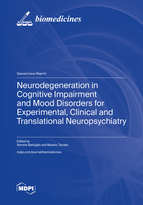Neurodegeneration in Cognitive Impairment and Mood Disorders for Experimental, Clinical and Translational Neuropsychiatry
A special issue of Biomedicines (ISSN 2227-9059). This special issue belongs to the section "Neurobiology and Clinical Neuroscience".
Deadline for manuscript submissions: closed (31 October 2023) | Viewed by 25228
Special Issue Editors
2. Center for Studies and Research in Cognitive Neuroscience, Department of Psychology, University of Bologna, Bologna, Italy
Interests: NIBS techniques; TMS; skin conductance; heart rate variability; fear conditioning; fear learning; learning; neuropsychology; prefrontal cortex; amygdala; hippocampus; anxiety; depression; working memory; PTSD; skin conductance responses; psychophysiology; error-related negativity; EEG; tDCS; Alzheimer’s disease; PIT; stress-related disorders; Parkinson’s disease; resilience; memory; neurologic patients; cognitive decisions; fMRI; translational and molecular psychiatry
Special Issues, Collections and Topics in MDPI journals
Interests: neurohormones; neuropeptides; tryptophan; kynurenine; psychiatry; neurology; depression; anxiety; dementia; pain; Alzheimer’s disease; cognition; antidepressant; translational research
Special Issues, Collections and Topics in MDPI journals
Special Issue Information
Dear Colleagues,
Neurodegeneration is the progressive atrophy and subsequent functional loss of neurons, which is responsible for the pathogenesis of neurodegenerative diseases as well as psychiatric disorders. The degenerative change of neurons may take place from molecular, cellular, histological, and functional to organizational levels, may initiate in the prodromal stage as early as during the gestational period in neurodevelopmental disorders, and may proceed to progression and exacerbation of neuropsychiatric symptoms in mental illnesses. Particularly important is to understand degenerative change in the neural correlates of consciousness and attention to cognitive and emotional domains in the development of neuropsychiatric disorders. Thus, probing neurodegenerative change carries great importance in terms of detecting susceptibility, understanding pathogenesis and progression, and discovering novel therapeutic targets. Moreover, many branches of neuroscience can help us to understand the underlying biological factors and neural computations behind brain impairments, neurodegeneration, and psychiatric disorders, as well as determine where and how to focus research and treatment. Currently, the great majority of neurodegenerative diseases lack effective disease-modifying treatments, thus highlighting the urgent need for new and effective therapeutic strategies. In recent years, non-invasive brain stimulation (NIBS) techniques, such as transcranial magnetic stimulation (TMS) and transcranial electric current stimulation (TES), have been developed and are currently being investigated in patients with neurodegenerative disorders for both diagnostic and therapeutic purposes.
This Special Issue highlights the most recent advances in experimental, clinical, and translational research in the fields of neuropsychiatry, focusing on neurodegeneration and neural correlates in the development of cognitive impairment and psychiatric emotional disturbance. We cordially invite authors to contribute comprehensive review and original research articles focusing on (but not limited to) the following:
- Etiology, pathogenesis, and progression mechanisms;
- Early diagnosis including biomarkers, bioimaging, and biosensors;
- Prophylactic, disease-modifying, and therapeutic strategies, novel targets;
- Novel drug discovery and development, naturally driven biomedicines, natural bioactive molecules and vaccines;
- Preclinical in vitro models and animal models;
- Bench-to-bedside translational research;
- Bedside-to-bench translational research;
- Non-invasive brain stimulation (NIBS) to diagnosis and treatment of neurodegenerative and psychiatric disorders.
Dr. Simone Battaglia
Dr. Masaru Tanaka
Guest Editors
Manuscript Submission Information
Manuscripts should be submitted online at www.mdpi.com by registering and logging in to this website. Once you are registered, click here to go to the submission form. Manuscripts can be submitted until the deadline. All submissions that pass pre-check are peer-reviewed. Accepted papers will be published continuously in the journal (as soon as accepted) and will be listed together on the special issue website. Research articles, review articles as well as short communications are invited. For planned papers, a title and short abstract (about 100 words) can be sent to the Editorial Office for announcement on this website.
Submitted manuscripts should not have been published previously, nor be under consideration for publication elsewhere (except conference proceedings papers). All manuscripts are thoroughly refereed through a single-blind peer-review process. A guide for authors and other relevant information for submission of manuscripts is available on the Instructions for Authors page. Biomedicines is an international peer-reviewed open access monthly journal published by MDPI.
Please visit the Instructions for Authors page before submitting a manuscript. The Article Processing Charge (APC) for publication in this open access journal is 2600 CHF (Swiss Francs). Submitted papers should be well formatted and use good English. Authors may use MDPI's English editing service prior to publication or during author revisions.
Keywords
- Alzheimer’s disease
- Parkinson’s disease
- aging decline
- mild cognitive impairment
- multiple sclerosis
- stroke
- psychiatric disorders
- depressive disorder
- bipolar disorder
- post-traumatic stress disorder
- anxiety disorder
- schizophrenia
- somatic symptom disorder
- autism spectrum disorder
- hyperactive attention deficit disorder
- learning disabilities
- acquired brain damage
- altered cognitive processes
- brain functional impairment
- neurocognitive disorders
- cognitive, behavioral, and functional disorders
- acquired trauma
- brain plasticity and connectivity
- non-invasive brain stimulation
- diagnosis and treatment
- functional evidence of altered cognition and connectivity








